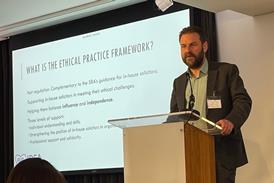The difficulties encountered in Landlord and Tenant Act cases under the Civil Procedure Rules (CPR) have been widely discussed.
Part 56 of the CPR has now been introduced and is scheduled to come into force on 15 October 2001.
It is intended to solve the problems.Part 56 primarily addresses landlord and tenant claims and most significantly those by which new business tenancies are sought under the Landlord and Tenant Act 1954.
Part 56 has attracted a high degree of criticism from many quarters.
Those who practise property litigation are generally of the view that part 56 creates many more problems than it could have solved.The introduction of the CPR was to some extent so hurried that many issues had to be put to one side to await scrutiny at a later date.
This resulted in the rather bizarre retention of many provisions of the Supreme Court and the County Court Rules as schedules 1 and 2 to the CPR which have then been more fully incorporated on a piecemeal basis.Since that caused some significant confusion in property cases -- including landlord and tenant cases -- practice direction 8B was introduced.
In county court business tenancy renewal cases, that only created more confusion with some courts asking for claims to be issued using old form N397 and some requiring new form N208.
Some courts issued the claim form fixing a hearing date in accordance with part 8B and some did not, preferring to continue with pre-CPR practice.The immediate problem is that a procedure that had been fine-tuned over many years has had to be shoehorned into one of two types of claim -- part 7 or part 8.
Part 8 has prevailed.
This brings with it the requirement to file an acknowledgement of service and to deal with the filing of evidence, all in accordance with part 8.Most pre-CPR tenancy renewals simply sat on the court file and were often frequently forgotten -- reflecting the fact that the tenant only issued because the Act required it to.
Often there is a settlement, albeit negotiated over some time.An attempt has been made to address that, with the landlord being given the power to request a three-month stay when the tenant's claim is served.
It seems odd that only the landlord can request the stay and that the court does not appear to have power to extend it beyond three months.Only if the parties request that the stay be lifted will the court give directions in the 'usual' way.
In these circumstances the automatic evidence timetable does not apply.If there is no request for a stay, the landlord must file an acknowledgement of service (AoS).
The AoS is curious.
It requires more or less all the information that was formerly given in an answer to a pre-CPR tenancy renewal and can include an application for interim rent.
The filing of the AoS triggers the timetable for the filing of evidence -- see part 56.3 (10) & (11).The tenant, as claimant, files its evidence first.
There are a number of problems with this.
First, as at the date at which evidence is being filed, the court will not have given permission for the use of expert evidence; yet tenancy renewals are as classic a case one will encounter in which expert valuation evidence will be necessary.Second, it is difficult to see what evidence will be required which will not have been introduced by the claim form that is endorsed with a statement of truth (see part 8.5 (7) CPR).
The same will not be true for the landlord, since the AoS is not a claim form, even though in this case it could be said to have similar characteristics if it can include an application for interim rent.Third, in many cases the tenant does not know the case it has to meet and this is the case whether the landlord is putting forward terms for the new lease or the landlord is objecting to the tenant having a new lease at all.Fourth, assuming the tenant takes the obvious risk and instructs an expert before the court has given permission for expert evidence, the expert will have little or no idea of the valuation date to work to at such an early stage in the proceedings.The landlord then files its evidence.
The need to file all evidence has been diminished to some extent by the introduction of a late amendment to the practice direction to part 56 (paragraph 3.8) which says that the evidence should be sufficient to allow the court to decide what additional directions and evidence may be required.
But the primary obligation to file evidence under part 56.3 (10) and (11) remains.With the introduction of paragraph 3.8 of the practice direction to part 56, an attempt has been made to cater for the often-required trial of a preliminary issue.
If a landlord opposes the tenant's claim for a new tenancy, the question as to whether the landlord satisfies the statutory ground of opposition should almost always be considered first.
Paragraph 3.8 touches on this.Since part 56.3 (12) and paragraph 3.8 of the practice direction to part 56 in combination envisage further directions and evidence and the possibility of a trial of a preliminary issue, one inevitably wonders what the purpose of part 56.3 (10) and (11) must be.
Surely, while trying to fit the lease renewal into part 8 procedure, it would have been better to have directed that the matter be referred for directions on the filing of the AoS, or the lifting of the stay, so that evidence -- and all other matters -- could be addressed early on in an appropriate manner, thereby avoiding the need for what appears to be a wholly inappropriate and unnecessarily costly step of putting in 'general' evidence.Paragraph 3.8 of the practice direction to part 56 is an amendment introduced before part 56 has even come into force.
Perhaps additional amendments should follow.Clearly it is not appropriate to have numerous types of procedure and pre-CPR practices, but it does seem as if too much effort has been made to fit landlord and tenant cases into part 8 via part 56.
Was it necessary? Prior to the CPR, there were examples of special types of procedure that existed quite happily in parallel with mainstream claims.
Could that not have been the case now? If not, why have part 56 at all? Why not just amend part 8 in an appropriate manner, or substitute a revised part 8B?Most of the pro-part 56 commentary has come from those who do not practise property litigation day in, day out.
They forget two things.
First, the parties are only involved in litigation because the Act requires it; the vast majority of non-contested tenancy renewals are settled.
If they think the CPR should be used to strike out an application, the effect of which may result in a perfectly lawful and hea lthy business being disrupted, they forget the Human Rights Act.Second, one of Lord Woolf's principal objectives, which is embodied in the overriding objective, is the reduction of the cost of litigation.
It is difficult to see how the interests of landlords and tenants are served by being required to litigate when they wish to negotiate in an orderly manner.If either party is unhappy, the court should be there to ensure that the dispute is resolved, but otherwise the parties should be free from compulsory litigation.Part 56 represents a lost opportunity to improve the conduct of business tenancy renewal cases under the Act.
The sooner the proposed changes to the Act are implemented, the better.



























No comments yet